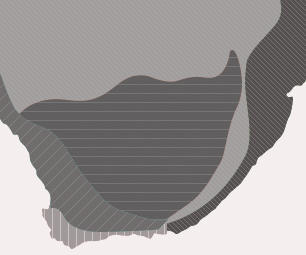Sterculia murex
Sterculia murex Hemsl.
Family: Malvaceae
Common names: lowveld chestnut(E), laeveld kastaiing (A) umbhaba (Swazi), mohlatsane (N Sotho)
SA Tree No: 475
Introduction
It is not only the beauty of the flowers that creates interest in this tree, but also the unique appearance of its fruit and the lovely, palmately compound leaves.

Description
Description
Sterculia murex grows up to 6-12m with wide, with spreading branches and 1-2 m stems up to 30 cm in diameter. The stem is covered with thick, ribbed, gray-brown bark. In old wood, the bark becomes almost black and is cracked into rectangular segments.

The leaves are borne on long hairy stalks, and are composed of 5-10 stalkless leaflets radiating, finger-like from one point. They are oblong to widely lance-shaped, narrowed to both ends, pointed, usually up to 10 cm long and 5 cm wide. The leaves are velvety both sides, the midrib, secondary veins and the netted veins conspicuous on the lower surface.
Sterculia murex flowers in sprays at the ends of the usually bare branches from August to October. They are waxy and yellow, marked with brown or crimson flowers. As in all the Sterculias, the petals are absent while the sepals are petal-like.

The five-lobed fruits are unique in appearance. They are large (up to 30cm in diameter if all lobes develop), woody and covered thickly with hard spines. The shell contains large oval seeds, resting in a bed of stinging hairs that can be irritating on contact with the skin or eyes. It is seldom that a very big complete fruit is collected as they grow high on the tree and shatter as they fall.
Distribution and habitat
Distribution description
The lowveld chestnut grows well on the hills near the Pretorius Kop entrance to the Kruger Park. It grows in a limited number of areas in Mpumalanga, most often on wooded, rocky hills, and also in Swaziland.
Derivation of name and historical aspects
History
The genus Sterculia was named after the Latin god Sterculius. The specific epithet "murex" is also Latin meaning, "having rough parts" or "prickly" in reference to the spiky fruits. Despite its common name this tree is not related to the true chestnuts.
There are about 150 species in this fascinating African and Asian genus. Of the five species of Sterculia found in southern Africa, only Sterculia murex and Sterculia alexandri have attractive, digitately compound leaves. Sterculia alexandri is a very rare tree, a red data listed plant, only found in several isolated areas of the Eastern Cape near Port Elizabeth. The family Sterculiaceae also contains the genus Dombeya, several species of which are cultivated and have been described in this series.
Ecology
Ecology
The sweet, oily seeds are relished by baboons and monkeys, and after roasting, are enjoyed by humans too.
Palmer and Pitman (1972) report that these trees are not popular with cotton farmers for they are a breeding place of the "cotton stainers".
Uses
Use
The open fruit shell makes an unusual ash-tray, and is not easily charred by lighted cigarettes.
The tree is mainly grown for decorative effect as the wood is soft and of little use.
Growing Sterculia murex
Grow

This is an unusual and quick growing tree for warm gardens. It is not frost tolerant and prefers well drained soils and a relatively high rainfall. Although it comes from the subtropical summer rainfall part of the country, trees are growing and flowering at Kirstenbosch which has a winter rainfall, mediterranean climate.
Sterculia murex is usually grown from seed. Fresh seed germinates readily. The roots are formed first and the leaves only appear above the soil or the growing medium after a few months. For better germination, the seed should be placed on top of the soil. To prevent fungal diseases, treat the seed with a fungicide before planting. A growing medium of 50% bark mixed with 50% polysterine is suitable. The seed tray should be kept damp and placed on a bench or a raised bed to protect the seed from rats and mice, who seek out the protein rich seeds.
References
- Coates Palgrave, K. 1983. Treesof Southern Africa, Cape Town, C Struik Publishers.
- De Winter, B. et al. 1966, Sixty-six Transvaal Trees, Pretoria, Botanical Research Institute, Department of Agricultural Technical Services.
- Hilton-Taylor, C.1995, Red Data List of Southern African Plants, Pretoria, National Botanical Institute.
- Palmer, E. and Pitman N, 1972, Tree of Southern Africa, Cape Town, AABalkema.
- Van Jaarsveld, E. 2001, Personal Communication.
- Van Wyk, P. 1984, Field Guide to the trees of the Kruger Nationl Park, Cape Town, C Struik Publishers.
Credits
Giles Mbambezeli
Kirstenbosch National Botanical Garden
with additions by Yvonne Reynolds
June 2002
Plant Attributes:
Plant Type: Tree
SA Distribution: Gauteng, Limpopo, Mpumalanga
Soil type: Sandy, Loam
Flowering season: Spring, Winter
PH: Neutral
Flower colour: Green, Red, Yellow
Aspect: Full Sun
Gardening skill: Easy
Special Features:
Horticultural zones









Rate this article
Article well written and informative
Rate this plant
Is this an interesting plant?
Login to add your Comment
Back to topNot registered yet? Click here to register.